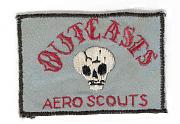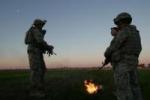Lance Cpl. Luke McDonell, a rifleman with Lima Company, 3rd Battalion, 4th Marine Regiment, scans the tree line during a security halt while patrolling the area of Now Zad, Afghanistan, known as "The Greens," on December 9th, 2009. The Marines cleared the area as part of Operation Cobra's Anger, an operation aimed at removing the Taliban's stronghold of the area. McDonnell is a 28-year-old from Chippewa Falls, Wisconsin.
HELMAND PROVINCE, Afghanistan - Once an urban district and home to thousands, "The Greens," an area within the Now Zad region of Afghanistan quickly became a ghost town, when Taliban fighters procured the area from which to launch combat operations.
With the Taliban in control and the civilian population gone, the area's alleyways were quickly laced with improvised explosive devices, its orchard's filled with bunkers and fortified fighting positions, and its adobe homes stocked with weapons caches and enemy fighters.
While few coalition units have dared to enter The Greens, the Marines and sailors of Lima Company, 3rd Battalion, 4th Marine Regiment, did exactly that Dec. 8-9 as part of Operation Cobra's Anger.
The Marines of Lima Co. moved swiftly to clear compounds, homes, alleyways and orchards, and it quickly became clear the Taliban had become complacent in the safety they believed The Greens provided them and were unprepared to deal with such an assault.
"We went in there for our first time and there wasn't anybody occupying the area, but we did find a lot IED making facilities, [homemade explosives], pressure plates and stuff like that," said Lance Cpl. Stewart Heim, 20, a rifleman with Lima Co. "It definitely showed us the Taliban were occupying [the Greens], and using it as a centralized place between towns."
Lima Co. also confiscated illegal drugs, Taliban propaganda and uncovered tunnel systems used by enemy fighters.
"We found their tunnel systems which pretty much run throughout the whole Greens," said Heim, a native of Staunton, Ill. "So we've definitely seen that they have the capability to survive us dropping bombs on them."
Lima Co. came to the area expecting their Taliban rivals to defend the ground they've controlled for many months. With the Marines rapidly chipping away at Taliban caches and exposing fighting positions, an attack by Taliban forces to save what supplies remained, seemed even more imminent.
"Walking through The Greens was kind of iffy. You didn't know where you wanted to step, where to step, where not to step. You never knew what to expect around a corner," said Lance Cpl. Michael R. Evans, 19, a combat engineer attached to Lima Co., 3/4. "You'd open up a door and might see a chicken or a dog and it would surprise you since you knew there was nothing out there."
Enemy fighters chose not to engage the Marines and instead left the dirty work for the many IED's positioned throughout the area.
While the IED's were numerous, the Marines' sharp eyes, training and metal detectors were able to locate all devices encountered before they could inflict casualties.
"We found them the way we should find them, instead of having someone stepping on them and having to be [medically evacuated]," said Evans, from McKenzie, Tenn.
The Marines continued to push farther into the area, destroying IED's along the way, gathering information and slowly but surely, breaking the Taliban's reign over the area.
After two days of defying Taliban threats and venturing farther and farther into the area, the Marines returned to friendly lines to refit and resupply.
While many alleyways in the area remain to be negotiated, the Marines set an example for Afghan national security forces and coalition forces to follow, and energized the mission to rid Now Zad of Taliban influence and return it to the Afghan people.
partially correct punch below the belt; however, as you well know from your days with the OSS during WWII and then with SF in Vietnam War that UW is only one of our SOF missions, and not one that SOCOM leadership embraced warmly during the early days of the conflict. Most folks are wiser now.



















Bookmarks